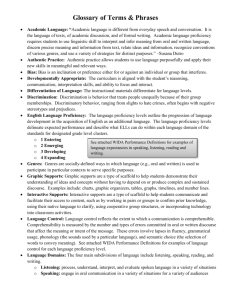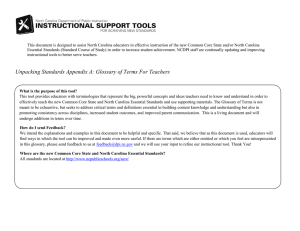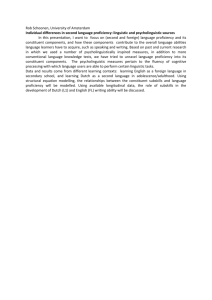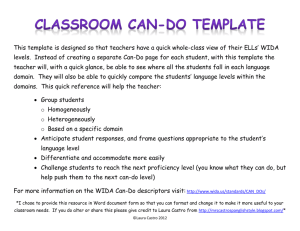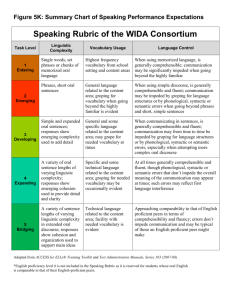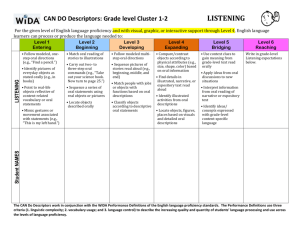WIDA Writing Rubric & Glossary of Term
advertisement
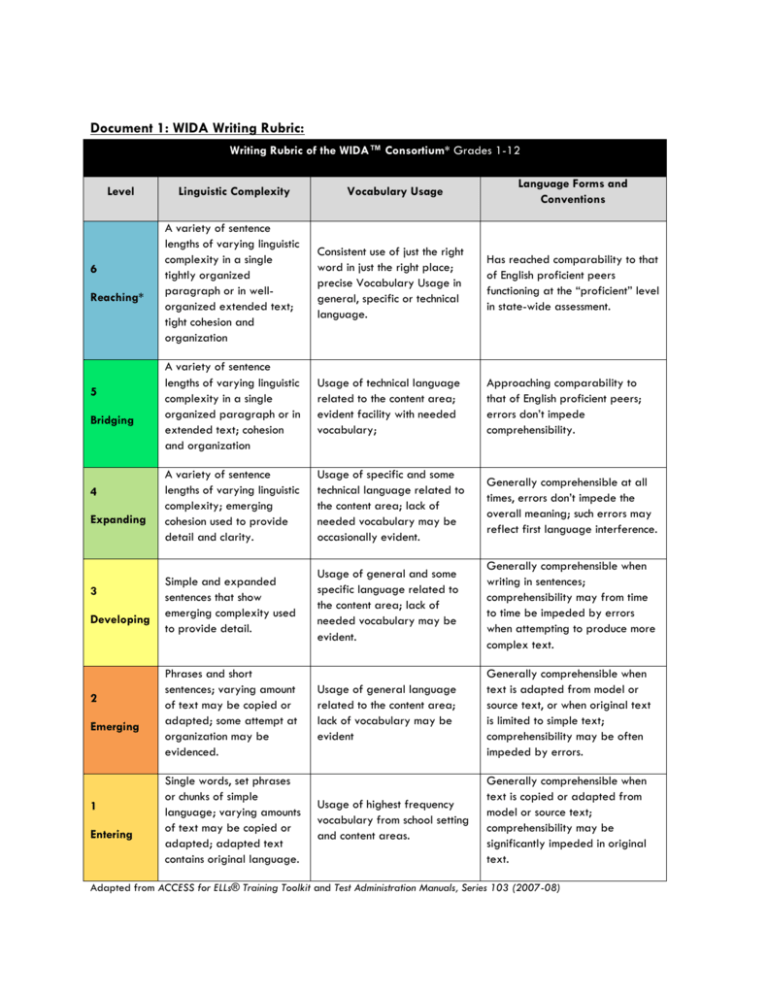
Document 1: WIDA Writing Rubric: Writing Rubric of the WIDA™ Consortium* Grades 1-12 Level 6 Reaching* 5 Bridging 4 Expanding 3 Developing 2 Emerging 1 Entering Linguistic Complexity Vocabulary Usage Language Forms and Conventions A variety of sentence lengths of varying linguistic complexity in a single tightly organized paragraph or in wellorganized extended text; tight cohesion and organization Consistent use of just the right word in just the right place; precise Vocabulary Usage in general, specific or technical language. Has reached comparability to that of English proficient peers functioning at the “proficient” level in state-wide assessment. A variety of sentence lengths of varying linguistic complexity in a single organized paragraph or in extended text; cohesion and organization Usage of technical language related to the content area; evident facility with needed vocabulary; Approaching comparability to that of English proficient peers; errors don’t impede comprehensibility. A variety of sentence lengths of varying linguistic complexity; emerging cohesion used to provide detail and clarity. Usage of specific and some technical language related to the content area; lack of needed vocabulary may be occasionally evident. Generally comprehensible at all times, errors don’t impede the overall meaning; such errors may reflect first language interference. Simple and expanded sentences that show emerging complexity used to provide detail. Usage of general and some specific language related to the content area; lack of needed vocabulary may be evident. Generally comprehensible when writing in sentences; comprehensibility may from time to time be impeded by errors when attempting to produce more complex text. Phrases and short sentences; varying amount of text may be copied or adapted; some attempt at organization may be evidenced. Usage of general language related to the content area; lack of vocabulary may be evident Generally comprehensible when text is adapted from model or source text, or when original text is limited to simple text; comprehensibility may be often impeded by errors. Usage of highest frequency vocabulary from school setting and content areas. Generally comprehensible when text is copied or adapted from model or source text; comprehensibility may be significantly impeded in original text. Single words, set phrases or chunks of simple language; varying amounts of text may be copied or adapted; adapted text contains original language. Adapted from ACCESS for ELLs® Training Toolkit and Test Administration Manuals, Series 103 (2007-08) Document 2: WIDA Writing Rubric Consensus Scoring Chart: and Performing INDEPENDENT SCORING Overall Score Linguistic Complexity Rationale: Vocabulary Usage Rationale: Language Forms and Conventions Rationale: Areas of Strength: Areas for Improvement: SCORING AFTER CONSENSUS Appendix A: Glossary of Terms and Expressions Related to WIDA’s Standards academic content standards: the skills and knowledge expected of students in the core content areas for each grade level academic language: the oral and written text required to succeed in school that entails deep understanding and communication of the language of content within a classroom environment; revolves around meaningful application of specific criteria related to Linguistic Complexity at the discourse level, Language Forms and Conventions at the sentence level, and Vocabulary Usage at the word/phrase level within the particular context in which communication occurs amplified strands: a framework for representing the WIDA English Language Development Standards that extends to include examples of the three performance criteria of academic language (Linguistic Complexity, Language Forms and Conventions, Vocabulary Usage) across levels of language proficiency cognitive functions: the mental processes involved in learning cohesion: a feature of academic language at the discourse level involving the grammatical and lexical elements within and across sentences that hold text together to give it meaning collocations: words or phrases that naturally co-occur with each other, (e.g., “peanut butter and jelly,” or “a strong resemblance”) Common Core State Standards: the skills and knowledge expected of students in English language arts, mathematics (Kindergarten–Grade 12), and literacy in history/social studies, science, and technical subjects, (Grades 6–12); adopted by the vast majority of states in the U.S. in 2010 complementary strands: the use of the standards framework to represent critical areas of schooling outside the five English language development standards, including music and performing arts, the humanities, visual arts, health and physical education, technology, and engineering complex sentence: one independent clause joined by one or more dependent clauses with a subordinator such as because, since, after, although, or when or a relative pronoun such as that, who, or which (e.g., “When school started, the students were excited.”) compound sentence: two or more independent clauses joined by coordinating conjunctions (e.g., for, and, nor, but, or, yet, so), semicolons, or a semicolon followed by a conjunctive adverb (e.g., “School started today; the students were excited.”) content stem: the element of model performance indicators, derived from state and national content standards, including the Common Core State Standards and Next Generation of Science Standards, that provides a standards-referenced example for contextualizing language development connections to academic content standards: examples of the association or correspondence of content to language standards discourse: extended oral or written language conveying multiple connected ideas; its language features are shaped by the genre, text type, situation, and register domains: see language domains English language learners (ELLs): linguistically and culturally diverse students who have been identified (by a WIDA screener and other placement criteria) as having levels of English language proficiency that require language support to achieve grade-level content in English example context for language use: element of the standards matrix situating the representation of the English language development standards within a sociocultural setting that considers the register, genre/text type, topic, and task example topic: element of the standards matrix listing a theme or concept derived from state and national content standards that provides a context for language development expanded sentences: complete thoughts that contain descriptive language or two ideas that are combined using connectors (and, but, or) features of academic language: the performance criteria of oral and written communication that include Linguistic Complexity at the discourse level, Language Forms and Conventions at the sentence level, and Vocabulary Usage at the word/phrase level formulaic expressions: a feature of academic language at the sentence level that represents a string of words acquired as a single chunk, such (e.g., “How are you?”) framework: see standards framework general language: words or expressions not typically associated with a specific content area (e.g., describe or book) genres: socially-defined ways in which language (e.g., oral and written) is used to participate in particular contexts to serve specific purposes instructional language: the language that typifies classroom discourse from teacher to teacher across content areas, such as “Open your books to page ___.” instructional supports: sensory, graphic, and interactive resources embedded in instruction and assessment that assist students in constructing meaning from language and content integrated strands: a framework for representing the WIDA ELD Standards in which grade levels, language domains, and standards are combined in different configurations L1: the first language a student acquires; usually refers to a home language(s) other than English, although for some English language learners, L2 (English) may be developing simultaneously alongside L1 L2: the second language a student acquires; usually refers to English as an additional language language development standards: language expectations for English language learners represented within progressive levels of language proficiency language domains: the modalities of language; listening, speaking, reading, and writing language function: the purpose for which oral or written communication is being used; language functions guide the choices in language use and structure as well as the social relationships being established; first element of model performance indicators that indicates how English language learners process or use language to demonstrate their language proficiency language proficiency: a person’s competence in processing (through listening and reading) and producing (through speaking and writing) language Language Forms and Conventions: the grammatical structures, patterns, syntax, and mechanics associated with sentence level meaning; one of three criteria that constitute the Performance Definitions levels of language proficiency: the division of the second language acquisition continuum into stages descriptive of the process of language development; the WIDA ELD Standards have six levels of language proficiency: 1–Entering, 2–Emerging, 3–Developing, 4–Expanding, 5–Bridging, and 6–Reaching Linguistic Complexity: the organization, cohesion, and relationship between ideas expressed in the variety and kinds of sentences that make up different genres and text types in oral or written language at the discourse level; one of three criteria that constitute the Performance Definitions model performance indicator (MPI): a single cell within the standards matrix that is descriptive of a specific level of English language development for a language domain within a grade or grade-level cluster Next Generation Science Standards: the skills and knowledge expected of students in science and engineering; draft released for states’ review in May 2012 Performance Definitions: the criteria that define the Linguistic Complexity, Language Forms and Conventions, and Vocabulary Usage for receptive and productive language across the five levels of language proficiency productive language: communicating meaning through the language domains of speaking and writing proficiency: see language proficiency realia: real-life objects used as instructional supports for language and content learning receptive language: the processing of language through listening and reading register: features of language that vary according to the context, the groups of users and purpose of the communication (e.g., the speech used when students talk to their peers versus their principal) scaffolding: careful shaping of the supports (e.g., processes, environment, and materials) used to build on students’ already acquired skills and knowledge to support their progress from level to level of language proficiency simple sentence: an independent clause with a subject and a predicate; can also have a compound subject and/or predicate (e.g., “The students and teachers were excited.”) social language: the everyday registers used in interactions outside and inside school sociocultural context: the association of language with the culture and society in which it is used; in reference to schooling, understandings of sociocultural context revolve around the interaction between students and the classroom language environment, which includes both curriculum and those involved in teaching and learning specific language: words or expressions used across multiple academic content areas in school (e.g., chart, total, individual) standards framework: the components representing WIDA’s five ELD Standards, including the standards themselves, the Features of Academic Language, the Performance Definitions, and the strands of model performance indicators (standards matrix) standards matrix: the basic framework for representing the English language development standards including a strand of model performance indicators, connection to state content standards, example context for language use, cognitive function, and topic-related language strands of model performance indicators (MPIs): the five sequential or scaffolded levels of English language proficiency for a given topic and language domain within the standards matrix supports: see instructional supports technical language: the most precise words or expressions associated with topics within academic content areas in school text types: categories of text that employ particular language features for specific purposes topic-related language: grade-level words and expressions, including those with multiple meanings and cognates, that are associated with the example topic within the standards matrix visual support: accompanying the use of written or oral language with illustrations, photographs, charts, tables, graphs, graphic organizers, etc. to give ELLs additional opportunities to access meaning Vocabulary Usage: the specificity of words or phrases for a given topic and context; one of three criteria that constitute the Performance Definitions
